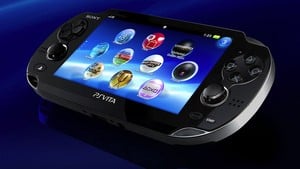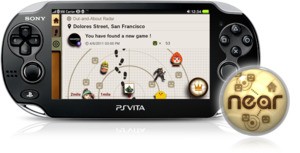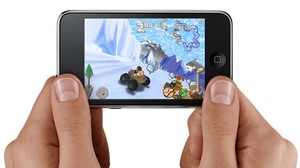
You need to hold the PlayStation Vita to understand why it matters. “Game changer” might be the term attached to Sony’s questionable US marketing campaign, but it’s an apt phrase. Staring down at Nathan Drake’s latest adventure on a device not much bigger than a pastry is a watershed moment: this is handheld gaming freed from the shackles that have plagued portable consoles in the past. And while it’s too early to say whether Sony’s latest slice of snazzy silicon will be enough to woo the mainstream market, it’s hard to fault the manufacturer’s desire to offer something tailored specifically to the needs of the enthusiast gamer.
With the system now widely available worldwide, we’ve spent the past several days soaking up as much reaction to Sony’s new hardware as we could possibly muster. And while the device is certainly not flawless, there’s a tangible excitement surrounding the PlayStation Vita that extends far beyond the new hardware honeymoon period. So what are people saying?
You Sexy Thing

Sony’s always made quality hardware, and the PlayStation Vita is certainly no exception. It’s a bulky system, but despite its size it's surprisingly light. Some commentators have criticised Sony for creating a device too large for the average pocket – let’s be honest, only clowns are going to be carrying around the Vita in their trousers – but Sony seems to understand it can’t compete with smartphones for on-body storage space. Instead, the PlayStation Vita feels like a direct response to the popularity of tablets, similarly large devices that thousands of people manage to squeeze into rucksacks, carrying cases or handbags.
But the PlayStation Vita’s bulk also plays host to its most prominent asset: the gorgeous OLED screen. It’s certainly the first thing you notice about the PlayStation Vita: big, bold and beautiful, the technology feels like a revolution. Switching between the 3DS and Vita makes the transition all the more apparent, with Nintendo’s small, low-resolution screen looking distinctly flat next to the Vita’s enormous, crystal-clear display. In fairness, one screen has the benefit of producing 3D, but reaction certainly seems to swing in the Vita’s favour.
Form is important, but function is even greater, and it’s alarming how well the PlayStation Vita’s shape has been received. In practice the device looks little more than a reshaped PlayStation Portable, but the Vita is surprisingly comfortable to hold over lengthy sessions. The curved shape of the system melts into your hands, with the analogue sticks surprisingly easy to reach. Those with smaller hands have complained that reaching the middle of the system’s touch screen can be a challenge when holding the device in a standard playing position, but from our experience this is more a fault with the software than the hardware. Titles such as Uncharted: Golden Abyss for example, cleverly purpose touch screen controls to the very side of the screen, allowing them to be easily accessed while your fingers hover over the action buttons.
The World Is In Play

Of course, hardware would be meaningless without the software to back it up, and PlayStation Vita arguably has the strongest launch line-up in history. One common complaint is the difficult decision of what to play next. First world problems and all, but some would argue the PlayStation Vita has too much great content at launch.
But even though there’s perhaps too much of it, the variety of the software is fantastic. Sony’s done a great job not only covering various genre touchstones, but ensuring it does it across multiple price points. The range of software is really quite staggering, from the lowly MotorStorm RC – which just might be in the running for most essential PS Vita launch title – right through to the more expensive, but no less compelling, FIFA Football.
Some of the third-party commitment has been disappointing, though. Sure, many of the big names are present – Ubisoft most prominently, delivering two of the most critically acclaimed launch titles in Lumines: Electronic Symphony and Rayman Origins – but there are also a number of big publisher absentees too. It would have been nice to see a little more support from wider pockets of the industry, but we’re sure that will follow.
Arguably the biggest missed opportunity in the PlayStation Vita’s launch offering is the absence of a solid first-person shooter. We’re a little startled that no publisher saw the value in even porting an FPS to the system, given the attention it would draw for purely technical purposes. In fact, with Resistance: Burning Skies still not due until May, there’s definitely set to be a shooter shaped hole in the Vita’s line-up for some weeks yet. Zipper Interactive’s Unit 13 – which is gathering plenty of enthusiasm for its combination of third-person shooter and social gaming experience – will attempt to plug that hole next month, but as strong as the SOCOM-inspired shooter looks, we’re still eager to get our first taste of first-person action on the Vita. Whether you love or hate the series, Activision’s Call of Duty on PS Vita is destined to become one of the platform's defining games.
If there’s any concern in the community regarding the PlayStation Vita’s software offering, it’s whether Sony can maintain the pace. Sure the launch offering looks strong, but there’s always the worry that things could dry up. With the aforementioned Resistance, Gravity Rush and Sound Shapes all imminent, that certainly doesn’t look likely in the immediate future, but Sony will need to use E3 as a platform to convince players that there’s still plenty more to come.
LiveArea

The award-winning XMB has become synonymous with PlayStation over the years, but in the transition to touch, Sony opted to implement a new interface for PlayStation Vita. Dubbed the LiveArea, the interface consists of a series of bubbles which transport users to “live” hub screens for games and software.
The design has drawn some criticism from various press outlets for its inconsistency and the manner in which it adds unnecessary steps to accessing content. It’s a fair criticism; the LiveArea for some applications is completely unnecessary and needs to be reconsidered in a future update. While we like that we can monitor our results in MotorStorm RC without needing to load the game, tapping through two screens to turn on Wi-Fi or access our trophies seems like a touch too many.
For all of its interface faults though, Vita’s operating system is well equipped. The system rivals the PlayStation 3 in terms of community feature set, serving up the long-anticipated cross-game chat that’s been at the foundations of many PS3 users’ most wanted list for years now. It transforms the PSN into a social network, allowing you to track your friends’ progress in various games and comment on it, and it’s all anchored by an omniscient notification system that keeps you up to date with everything happening around you.
Near, Sony’s location based social gaming service, has been rightfully criticised by some media outlets for its unwillingness to explain how everything works, but once you get to grips with sharing game goods within the environment it’s a legitimately compelling experience. It’s an exciting moment the first time you receive a gift from a stranger that you happened to cross paths with, and with clever development, Near could become the software that encourages players to take their Vita out and about. Sony needs to further develop this application though, because it’s not intuitive in its current guise and it risks putting people off the feature before it’s had time to establish itself.
Media vs. Market

For all of the goodwill surrounding Vita in gaming communities though, it’s surprising that the media has taken a much more cynical approach. Take CNET’s verdict on the system, which concludes that “hardcore gaming nuts would be better served by something like the iPod Touch.” It’s not a new comparison for those that have been following the build-up since Vita's announcement last year: conversation surrounding the system has been dominated by smartphones and tablets, with many outlets concluding that Sony’s latest device is simply too long in the tooth to compete in an App Store-dominated industry.
We may still be in the system’s honeymoon period, but with a wealth of quality software on the horizon, Sony doesn’t seem to want the party to end prematurely. What do you think of your Vita so far? Is it living up to your expectations or does Sony still have a lot to prove?





Comments 28
I loved it the first time I held it at E3 and I love it even more now. I haven't played a system this much since I got my Super Famicom in 1990.
@Corbs Playing Uncharted in bed is still amazing to me. I just can't believe it.
I'm surprised with how comfortable the system is too. I'm yet to really suffer from hand cramps, which nearly always happens with other portables.
I stayed up in bed last night playing Rayman Origins until almost 2am before I finally realized what time it was and went to sleep.
it is an awesome gaming device.....I don't subscribe to CNET's view that hardcore gamers are better served by an ipod touch........the launch line up is fantastic wiv a just a couple of crap titles in my opinion..........touch screen works very well .......at work the other night was playing uncharted made me laugh where you have to rub the screen or use the back touch for moving stuff. I know it isn't cheap but for me worth every penny.........on a final note for once we in the UK got a better deal than the States with wipeout 2048 for free from vodaphone for a £5 top up as opposed to super stardust delta both awesome games but 2048 the far more expensive game
@lezzzzzz Yeah, I was quite impressed with the free WipEout. Vodafone sent it through pretty fast for me too.
If you guys haven't tried out Mutant Blobs Attack yet, do so asap.
I've got a full Friends List and I constantly have friends and readers dropping me questions about what I'm playing or upcoming titles. With the PS3, this is either a lengthy, frustrating experience of trying to type with the DS3, or fetching my keyboard, but now I can instantly stop the game's action and utilize a full touchscreen keypad to chat with friends to seamlessly drop in and out of the games. The new interface is wonderful and I prefer it way above the PS3's.
The thing that keeps dropping in my mind while playing Vita, is that it could easily have been called PS3.5, or even PS4. It just feels that good!
@Slapshot I synced my trophies on PS3 last night and couldn't believe how long it was taking. I've been spoiled by the super swift Vita.
In truth, the only Vita launch title that has disappointed me was Army Corps of Hell. The other 15 games I've picked up are all solid. Now if I can just find time to finish them all. LOL
I'm happy with the way it's going. I've been infruriated with naysayers, mostly within the industry themselves - they can't see that this exact device has been on the wishlist of proper gamers since about a month after the original PSP was released.
I am really looking forward to watching them slowly succumb to the awesome experience on Vita. Rather like watching people switch from PC to Mac over a 10 year period after claiming over their dead body etc.
Long live PlayStation
i herd these things are freaking awesome!
u herd rite.
The Vita is just beautiful. I love the LiveArea interface. It works great for the Vita. Everything is so fast and smooth and the touch screen honestly feels and works better than my iPad imo. Now, time to wait for Gravity Rush!
And hey, my Vita fits in my skinny jeans pockets so that must mean something.
I love the vita, but I gotta have my Mario & Zelda, which is why I like the 3ds.... I won't be able to get the vita till my 16th birthday(June), so until then I'll be playing my 3ds, and when I get the vita, I'll play both.
@Corbs
I did the same thing last night. Played Rayman Origins till 7a.m. (started at 4). Thank God I don't have to worry about getting up early.
Can't wait for Sumioni
Rayman Origins simply blew me away. Golden Abyss was a known quantity (sampled at GamesCom), but how stunningly gorgeous Ancels art looks on Vita's OLED was truly a game-changing experience.
I held the Vita at my local Best Buy a few weeks ago (an associate had it dangling around his neck). If I hadn't already pre-ordered a Vita, I would have been sold on it because it was an awesome initial experience; beautiful design, quality, button placement, weight, and brilliant 5" screen. I havent been as excited for the handheld as much since the Game Boy days. I enjoyed the PSP, but didnt have the same feeling.
I have yet to further experience the Vita, since my system hasnt come in the mail yet... I really ought to of payed for faster shipping!
So, I activated the 3G on my Vita and it's simply fantastic to be able to play games and have the online interfaces that I normally have at home, on-the-go. NEAR is a blast to update while moving around the city and seeing what everyone is playing and there are a lot of people playing Vita in Mobile, AL.
wots good to see is so many positive comments.......like I said before it is such an awesome piece of kit.......I know I maybe a bit sad but just switching it on my excitement rises........in a years time it will be even better if that is possible.......
well done Sony 10/10 PS Vita Rules
Proposed yesterday, we're expecting....
But honestly surpasses all expectations... and just what i thought was possible for a handheld in general.
haha.... espn just had a Playstation Vita Live Look-In.... yay marketing!
Just got my Vita and am loving it so far.
lol @ CNET that's pretty oblivious of them to say "hardcore gamers better served by ipod touch". How does that even make sense in their mind?
@Squiggle55 Yeah, that baffled me too. I mean, I understand if they think iPod has a more viable market or whatever — but for hardcore gamers?
I think Vita is going to have really good word of mouth. Everyone that tries the system seems to come away impressed with it, and I'm seeing very little dissatisfcation from people that have stumped up the cash to buy one.
I had wrestled witrh the " Do I , Don't I " arguement for some time , but I am so glad I took the gamble . I have had many consoles home and handheld and I can say without doubt this is the best I have ever had . I haven't even got around to playing uncharted yet lol . I have eight games ranging from F1 to shinobido , uncharted to virtua tennis and others . I have yet to play one I didn't like and that is rare for me . Well done , This is a keeper .
look at that so excited about it I spelt with wrong
When I tried the demo unit at GameStop, I was underwhelmed. I now blame this on the fact that they have it attached to the wall with a really awkward harness and set on permanent mute. I didn't let that stop me from picking up my reserved Vita, and I'm loving the thing!
Uncharted manages to feel like a legit entry in the series in a way that no PSP game ever pulled off. Even though I didn't actually do much with Plants vs. Zombies on PS3, I'm loving the Vita version, probably because the touch and tilt controls suit the game so perfectly. Bought Stardust Delta, but I haven't gotten around to playing it yet. I HAVE spent some time with a PSP game, and I'm extremely impressed with how good they look on the Vita. Never before have I seen backwards compatibility THAT good. Now they just need to add more games to the functional list (and PSN in general, really).
Though I admit that the launch lineup for the Vita is large and varied, I must admit there aren't very many games for it I actually want. I'm still trying to decide whether to let my Trophy Freak rage over the PSN-level set on Touch My Katamari keep me from getting it...I'll probably cave at some point if I find the game on sale, but I don't really wanna drop $30 or even the $25 on PSN for it when PvZ had a full set at only $15. And yes, I know that's superficial and all that, no need for a debate over that here...just stating my opinion.
I discovered well over 100 Vita's through NEAR in my city yesterday, while having some fun with the 3G!
@Stuffgamer1 I'm simply amazed at Uncharted: Golden Abyss! Bend Studios has done a fantastic job injecting the new 'exploring' elements into the game and the SIXAXIS controls to fine-tune your aiming is genius! It's a game in itself worth picking up a Vita for.
@Slappy: Dang good thing too, seeing as I DID get the Vita at launch for that specific game.
Show Comments
Leave A Comment
Hold on there, you need to login to post a comment...